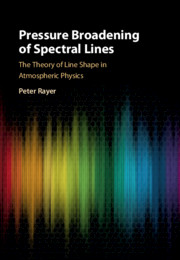Book contents
- Frontmatter
- Dedication
- Contents
- Preface
- Part One Preparing the Way
- Part Two Broadening Theory
- Part Three Atmospheric Spectra
- 7 Line Shape Theory
- 8 Absorption by GasesAbsorption by Gases
- Part Four The Background
- Appendix 1 State Space
- Appendix 2 Product Space
- Appendix 3 Projectors
- Appendix 4 Vector Operators
- Appendix 5 Quantum Dynamics
- Appendix 6 Scattering Theory
- Appendix 7 Resolvent Methods
- Appendix 8 Linear Response
- Appendix 9 Correlation Function
- Appendix 10 Complex Time
- Appendix 11 Absorption
- Appendix 12 Multipole Moments
- Appendix 13 Angular Momentum
- Appendix 14 The Wigner–Eckart Theorem
- Appendix 15 Reduced Amplitudes
- Appendix 16 Units and Other Matters
- Appendix 17 Plasma Spectra: Pointers
- Notes
- References
- Index
7 - Line Shape Theory
from Part Three - Atmospheric Spectra
Published online by Cambridge University Press: 26 June 2020
- Frontmatter
- Dedication
- Contents
- Preface
- Part One Preparing the Way
- Part Two Broadening Theory
- Part Three Atmospheric Spectra
- 7 Line Shape Theory
- 8 Absorption by GasesAbsorption by Gases
- Part Four The Background
- Appendix 1 State Space
- Appendix 2 Product Space
- Appendix 3 Projectors
- Appendix 4 Vector Operators
- Appendix 5 Quantum Dynamics
- Appendix 6 Scattering Theory
- Appendix 7 Resolvent Methods
- Appendix 8 Linear Response
- Appendix 9 Correlation Function
- Appendix 10 Complex Time
- Appendix 11 Absorption
- Appendix 12 Multipole Moments
- Appendix 13 Angular Momentum
- Appendix 14 The Wigner–Eckart Theorem
- Appendix 15 Reduced Amplitudes
- Appendix 16 Units and Other Matters
- Appendix 17 Plasma Spectra: Pointers
- Notes
- References
- Index
Summary
Starting from the very general Fano theory of pressure broadening, ways are sought to express the shape of a band of lines in a form that is more amenable to calculation. Initially, the far-wing is considered, and care is taken to ensure, by an adjustment, that the fluctuation–dissipation theorem is satisfied, despite Fano’s neglect of the initial correlations between the states of the radiator and the bath of its perturbers. The far-wing also requires, in a Fourier sense, the use of a very fine time scale, which allows the approach taken by Rosenkranz and Ma & Tipping, described first, to adopt the quasi-static approximation. In obtaining the overall line shape, the average over collisions may then be run across an ensemble of essentially static binary configurations. In the line core, the initial correlations may be ignored anyway, and, because a much coarser time scale is appropriate, the impact approximation may be invoked. Here, Fano’s theory is shown to reduce to that of Baranger, yielding expressions for fixed line shifts and widths, and allowing, through a perturbative approximation due to Rosenkranz, a simple expression to be derived to take account of line coupling.
Keywords
- Type
- Chapter
- Information
- Pressure Broadening of Spectral LinesThe Theory of Line Shape in Atmospheric Physics, pp. 259 - 322Publisher: Cambridge University PressPrint publication year: 2020



